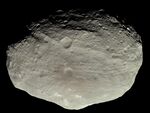Astronomy:(415029) 2011 UL21
| Discovery[1] | |
|---|---|
| Discovered by | Catalina Sky Srvy. |
| Discovery site | Catalina Stn. |
| Discovery date | 17 October 2011 |
| Designations | |
| (415029) 2011 UL21 | |
| 2011 UL21 | |
| Minor planet category | Apollo · NEO · PHA[2] |
| Orbital characteristics[2] | |
| Epoch 13 January 2016 (JD 2457400.5) | |
| Uncertainty parameter 0 | |
| Observation arc | 9379 days (25.68 yr) |
| |{{{apsis}}}|helion}} | 3.5091 astronomical unit|AU (524.95 Gm) |
| |{{{apsis}}}|helion}} | 0.73606 AU (110.113 Gm) |
| 2.1226 AU (317.54 Gm) | |
| Eccentricity | 0.65323 |
| Orbital period | 3.09 yr (1129.5 d) |
| Mean anomaly | 110.19° |
| Mean motion | 0° 19m 7.392s / day |
| Inclination | 34.845° |
| Longitude of ascending node | 275.60° |
| 284.74° | |
| Earth MOID | 0.0185982 AU (2.78225 Gm) |
| Physical characteristics | |
| Mean diameter | 2.5 km[3] |
| Mass | 2.1×1013 kg (assumed)[3] |
| Absolute magnitude (H) | 15.8[2] |
(415029) 2011 UL21, provisional designation 2011 UL21, is an Apollo class potentially hazardous asteroid discovered on October 17, 2011, by the Catalina Sky Survey project.[1] The asteroid is estimated to have a diameter of 2.5 kilometres (1.6 mi). It was rated at Torino Scale 1 on October 27, 2011, with an observation arc of 9.6 days.[4]
Description
2011 UL21 briefly had about a 1 in a million chance of impacting in 2029.[5] Its cumulative impact probability dropped to 1 in 71 million by 2 November 2011 when the observation arc reached 15 days. It was removed from the Sentry Risk Table on 4 November 2011 when all impact scenarios for the next 100 years or more were ruled out.[6] During 2029, the closest approach to Earth is 1.6 AU. Palomar Observatory precovery images from 1989 and 1990 have extended the observation arc to 22 years.[7] Its next notable close approach to the Earth will be on June 27, 2024, at a distance of 0.044 astronomical unit|AU (6,600,000 km; 4,100,000 mi).[8]
With an absolute magnitude of 15.8,[2] it is one of the brightest and therefore largest potentially hazardous asteroids (PHA) detected since (242450) 2004 QY2.[9] The next largest PHA (based on absolute magnitude) discovered in 2011 is 2011 WO41 with an absolute magnitude of 16.8.[9]
References
- ↑ 1.0 1.1 "MPEC 2011-U39 : 2011 UL21". IAU Minor Planet Center. 2011-10-28. https://www.minorplanetcenter.net/mpec/K11/K11U39.html. Retrieved November 1, 2011.
- ↑ 2.0 2.1 2.2 2.3 "JPL Small-Body Database Browser: (2011 UL21)". Jet Propulsion Laboratory. https://ssd.jpl.nasa.gov/sbdb.cgi?sstr=2011UL21. Retrieved 8 April 2016. "2012-04-18 last obs (arc=22 years)"
- ↑ 3.0 3.1 "Earth Impact Risk Summary: 2011 UL21". NASA/JPL Near-Earth Object Program Office. http://neo.jpl.nasa.gov/risk/2011ul21.html. Retrieved November 1, 2011.
- ↑ "Observations of small Solar-System bodies". hohmanntransfer. 2011-10-27. http://www.hohmanntransfer.com/mn/11/11300_1027.htm#2011UL21. Retrieved 2013-09-04. (1.5e-06 = 1 in 667,000 chance)
- ↑ David Morrison (October 26, 2011). "Should we be concerned about 2011 UL21". NASA Ask An Astrobiologist. https://www.astrobiology.nasa.gov/ask-an-astrobiologist/answered/2011/10/27/2058/. Retrieved 2011-11-06.
- ↑ "Date/Time Removed". NASA/JPL Near-Earth Object Program Office. https://cneos.jpl.nasa.gov/sentry/removed.html. Retrieved 2011-11-06.
- ↑ "2011 UL21 Orbit". Minor Planet Center. https://www.minorplanetcenter.net/db_search/show_object?object_id=2011+UL21. Retrieved 2012-05-17. "2012 04 18 (arc=22 years)"
- ↑ "JPL Close-Approach Data: (2011 UL21)". https://ssd.jpl.nasa.gov/sbdb.cgi?sstr=2011UL21;cad=1#cad. Retrieved 2012-05-17. "2012-04-18 last obs (arc=22 years)"
- ↑ 9.0 9.1 "JPL Small-Body Database Search Engine: PHAs and H < 17 (mag)". JPL Solar System Dynamics. https://ssd.jpl.nasa.gov/sbdb_query.cgi?obj_group=pha;obj_kind=all;obj_numbered=all;OBJ_field=0;ORB_field=0;c1_group=OBJ;c1_item=Ai;c1_op=%3C;c1_value=17;table_format=HTML;max_rows=100;format_option=comp;c_fields=AcBhBgBjBiBnBsCkCqAi;.cgifields=format_option;.cgifields=obj_kind;.cgifields=obj_group;.cgifields=obj_numbered;.cgifields=ast_orbit_class;.cgifields=table_format;.cgifields=com_orbit_class&query=1&c_sort=AcA. Retrieved 2011-11-20.
External links
- (415029) 2011 UL21 at NeoDyS-2, Near Earth Objects—Dynamic Site
- Ephemeris · Obs prediction · Orbital info · MOID · Proper elements · Obs info · Close · Physical info · NEOCC
- (415029) 2011 UL21 at ESA–space situational awareness
- (415029) 2011 UL21 at the JPL Small-Body Database
 |




